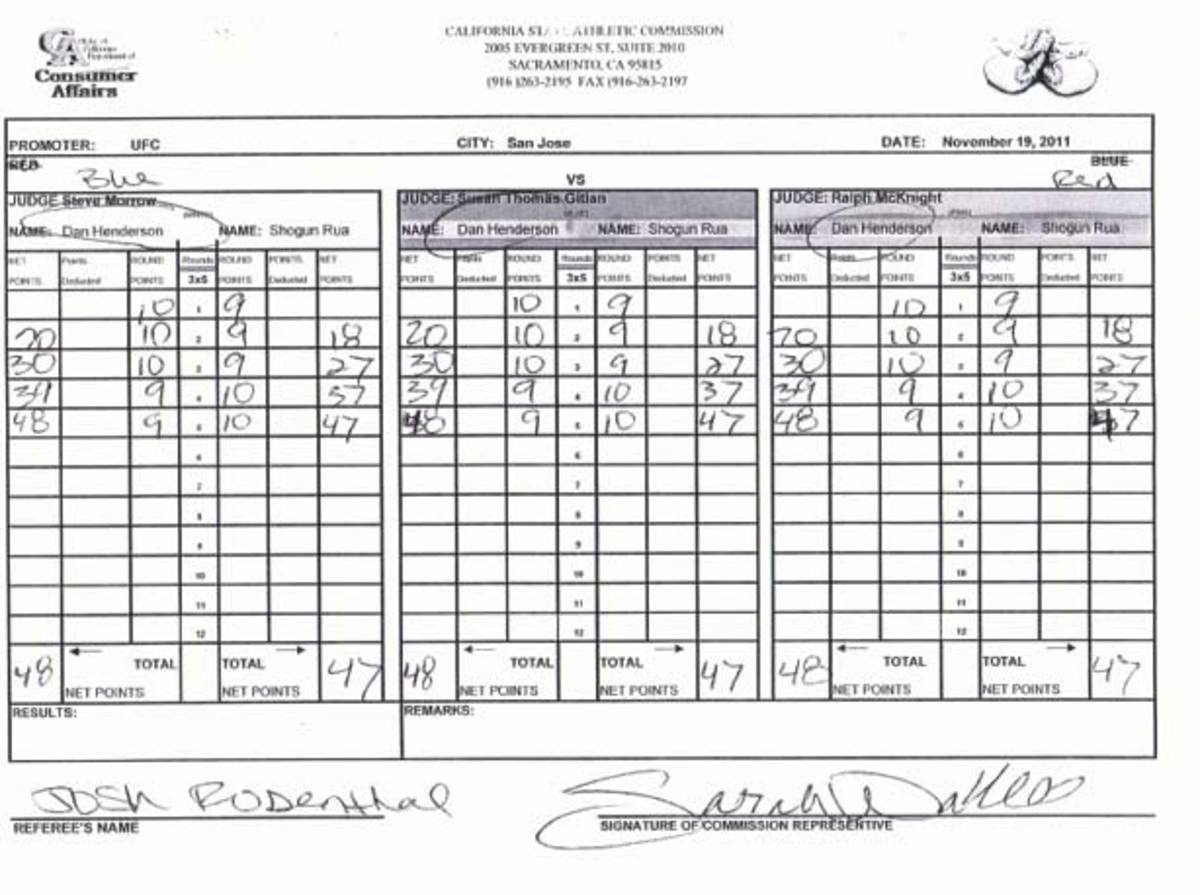Did judges score Henderson-Rua right?

There’s no argument that light heavyweight veterans Dan Henderson and Mauricio “Shogun” Rua put on one of the best fights of 2011 at UFC 139 two weeks ago in San Jose, Calif. The debate lied in how the judges scored the bout, particularly in the fifth and final round.

The California State Athletic Commission provided SI.com with the bout’s official scorecard, and some might be surprised to learn that there wasn’t a single 10-8 round awarded to either fighter. In fact, all three judges tallied the fight identically, giving Henderson the 48-47 unanimous decision.
As he always does after events, CSAC Executive Officer George Dodd held a brief meeting for all the officials who worked at UFC 139 that night. The Henderson-Rua scoring was discussed.
When it came to the fifth round, Dodd said that all three judges felt that “Shogun did win the round but did not do enough damage to score a 10-8 round,” he wrote via email. “He was in a dominating position but did not cause a lot of damage.”
How did the judges come to the 10-9 determination for Rua and not the 10-8 score some thought he deserved?
We have to first go to the verbiage that CSAC-licensed judges use in weighing each individual round. Like many states, California utilizes the definitions provided by the sport’s Unified Rules, which were drafted and adopted under the direction of the New Jersey State Athletic Control Board, promoters, existing MMA officials and others in April 2001.
Under the rule set’s 10-point must system, at least one competitor must be awarded a 10-point score in each round. Judges can award both fighters a 10 if they deem the round a draw. Here are the definitions for a 10-9 and 10-8 round:
10-9: When a contestant wins by a close margin, landing the greater number of effective legal strikes, grappling and other maneuvers
10-8: When a contestant overwhelmingly dominates by striking or grappling in a round
Remember, judges are also asked to weigh each round reviewing four criteria in the following order: effective striking, effective grappling, cage/ring control and effective aggressiveness and defense.
Keeping all of that in mind, there is no argument that Rua convincingly did enough to achieve a 10-9 score in the fifth round. The Brazilian landed a clean uppercut (effective striking) before they clinched and Rua threw the two-time Olympian to the mat, landing in side control (effective grappling). With four minutes left, Rua took full mount (effective grappling), though he was tired, evidenced by the energy he had left to expend in such an advantageous position. Rua connected with only a few of the punches he threw (effective striking weighed carefully here by what connected and how hard he hit) as Henderson covered up, hugged him to close the distance and even fired back one punch from bottom position (effective defense).
While he was able to push off and create space away from the fence to escape being pinned, Henderson also recovered half-guard (effective defense), but Rua achieved mount (effective grappling) a second time at the 2:40 mark. Henderson flipped to his stomach and back again multiple times, regained and lost half-guard again and even escaped from underneath Rua for a brief second (effective defense), as Rua peppered him with shots (weighed effective striking) for the final half of the round.
Rua landed enough to outscore Henderson with effective striking, and dictated the entire round to take cage control and effective aggressiveness. Both fighters scored with effective grappling (Henderson with defense).
But did Rua “overwhelmingly dominate” the round? The answer is no. His punches lacked power (understandably so after the great performance he’d put on for 20-plus minutes, but it still negates effective striking to a degree) and though he achieved mount multiple times, he couldn’t keep position for long to inflict enough damage (which influenced how the judges weighed his effective grappling as well).
Henderson did almost nothing but defend, but that was enough (along with his opponent’s fatigue) to keep the round from tipping toward an overwhelming ruling for Rua.
In addition, there wasn’t any moment in the fifth round where referee Josh Rosenthal, another experienced veteran, positioned himself to step in to stop the fight. In fact, Rosenthal didn’t give any verbal warnings to either to improve position or defend himself because he didn’t need to. Both were already doing it on their own.
Truthfully, all of the rounds merited 10-9 scores because they were all back-and-forth battles where neither fighter overwhelmingly dominated enough during any five-minute period. Each fighter had moments of strength and weakness throughout, but because we were watching two high-caliber fighters with years of experience behind them, neither would allow the other to tip the bout into the realm of 10-8 scoring. Neither could break the other, which made it some of the best 10-9 rounds the sport has ever offered.
-- Loretta Hunt
